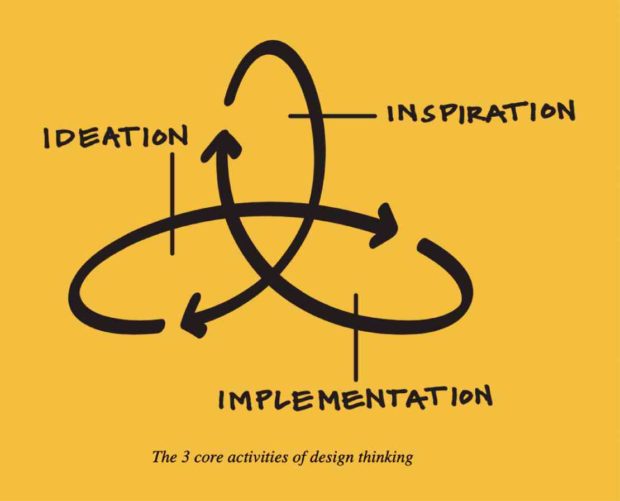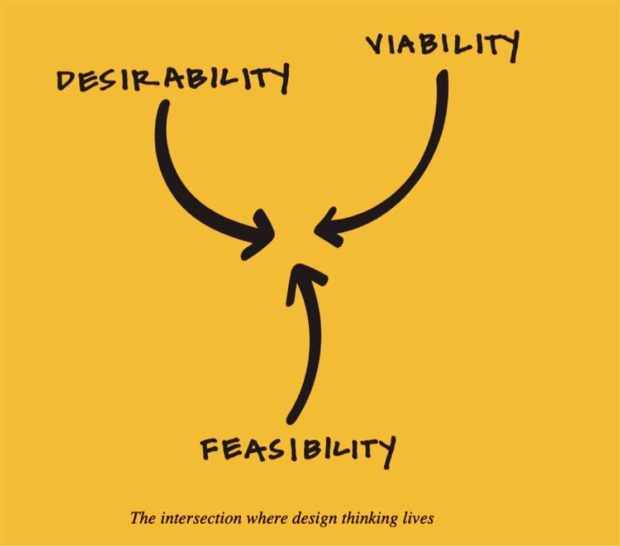Design and design thinking

It was a book authored by Tim Brown who is in the design industry himself. Bright red cover, with bold words of “change” and “design.” How could it be any different to what I do every day as a professional designer? What was the difference of this supposedly new method to what people like myself in the design industry have been doing all our professional lives? Why this sudden interest in the concept of “design” as a method for thinking?
The author states that “design thinking is a human-centered approach to innovation that draws from the designer’s toolkit to integrate the needs of people, the possibilities of technology, and the requirements for business success.”
Let’s go further into this by looking back at the educational system of the last 50 years.
Logic thinking was heavily promoted with math and sciences at the forefront, and with creativity as the least favored outcome of an education. This kind of mental programming has become the foundation from which most businesses today are built upon: precepts that are analytical and logical.
These businesses have been structured into multi-disciplinary functions like research and development, business development, marketing, sales and operations, to name a few. These disciplines develop products, commodities or services through methods that are long, bureaucratic and time-consuming.
As the world quickly and continually evolves with consumer demands frequently shifting, business organizations are pressed to move quickly on incorporating new value into their products, having realized that only knee-jerk reactions to these external changes will keep them from the fate of a Kodak or a Blackberry, enterprises that refused to change with the times, their inactions tantamount to self-destruction.
And then we have the creatives, a naturally chaotic, ambiguous and fluid bunch. By their nature, creatives derive solutions that seem to have been pulled from the air and not necessarily from a logical or codified method. Their processes appear to be random and often incomprehensible by people who are trained in the traditional methods of linear thinking.
The ability of creatives to go against the accepted thought patterns ignites exploration and develops new possibilities. Though their unpredictability can be disturbing, the output of creative thinking can turn out to be all-encompassing and unprecedented.
For the business organizations existing today, design thinking is a solution that integrates creativity into their established business models in order to swiftly react to the demands of their clientele.
To respond to demands, businesses need to re-design, and to re-design, they need to re-imagine. The process of design thinking codifies the random creative process into a step-by-step course of action that harnesses the various skills present in their enterprise in order to develop quick, creative solutions. It enables multi- disciplinary participants in an organization to become problem finders and solvers wherein the process of extracting creativity is made methodical and orderly, and therefore palatable in a business environment.
The goal of the process is to harness ideas through the interaction of “designers,” collaborating and brainstorming, with empathetic mindsets that function much like how we architects wear our imaginary user’s shoes and walk our way through the spaces we are creating.
Is it pleasant? Does it answer the need? Did it solve the problem? Does it feel right?
Understanding each other’s disciplines and being objective and accepting of the preferences, knowledge, biases and inherent prejudices that we may or may not possess ourselves, can create the unique melting pot where ideas can blend into new solutions.
Professional designers, however, have gone through rigorous training in both creative and critical thinking, and this spells the huge difference in the process of coming up with results. Professionals in the creative industries go through a large degree of critiquing in their training and have been taught to dig deep into their pot of options and to explore ideas laterally, and even radially. They think beyond merely “outside the box,” even when not prompted to do so.
In all their angst and exasperation, will go into every nook and cranny of their brains for indisputable solutions to a problem.
While distilling thoughts through the design thinking process narrows down random solutions into a choice set within a limited amount of time, the process itself may lack the ability to harness deeper answers. The solutions are often shallow and diluted given the multi-disciplinary nature of a business enterprise. For the design professional and the creative however, design thinking has given them credibility and importance inside of the boardroom.
Finally, the much maligned random creative spark is acknowledged as a powerful contributor to the processes that help businesses respond quickly to the needs of their market and helps them in re-creating their products swiftly.
With design thinking, business organizations succeed, not only in their bottom line, but in their ability to deliver new value in products and services.
